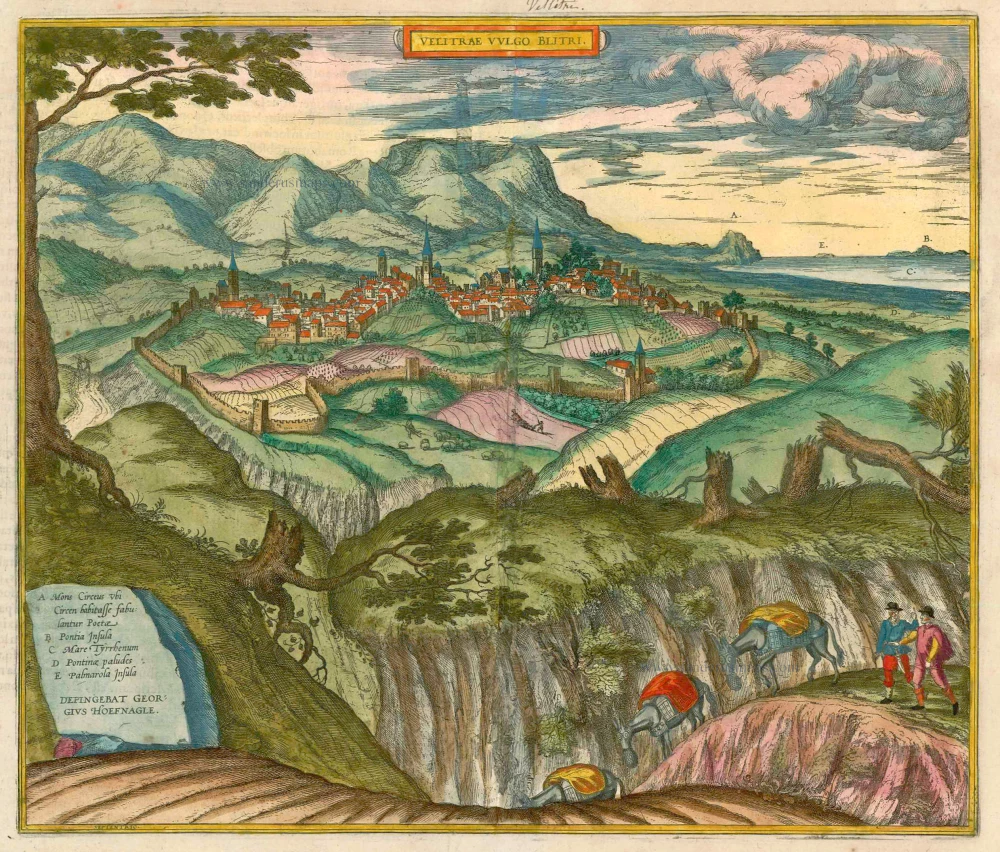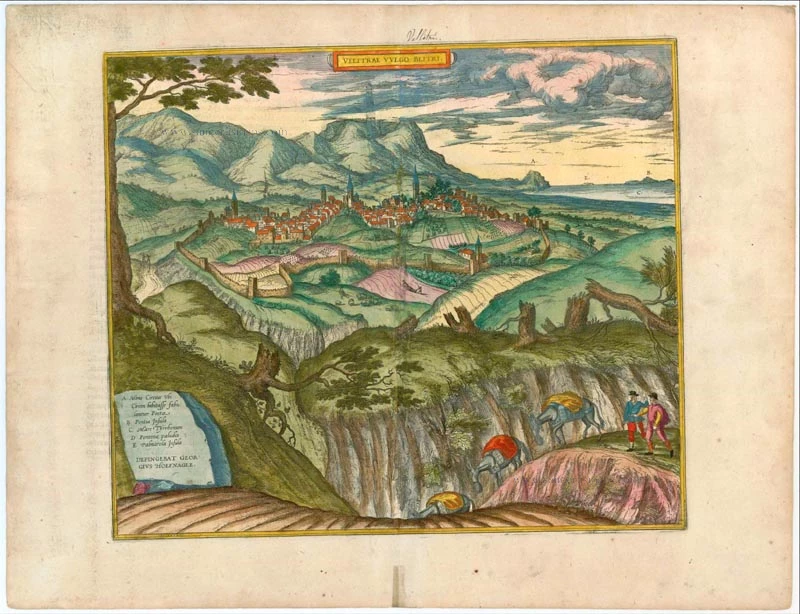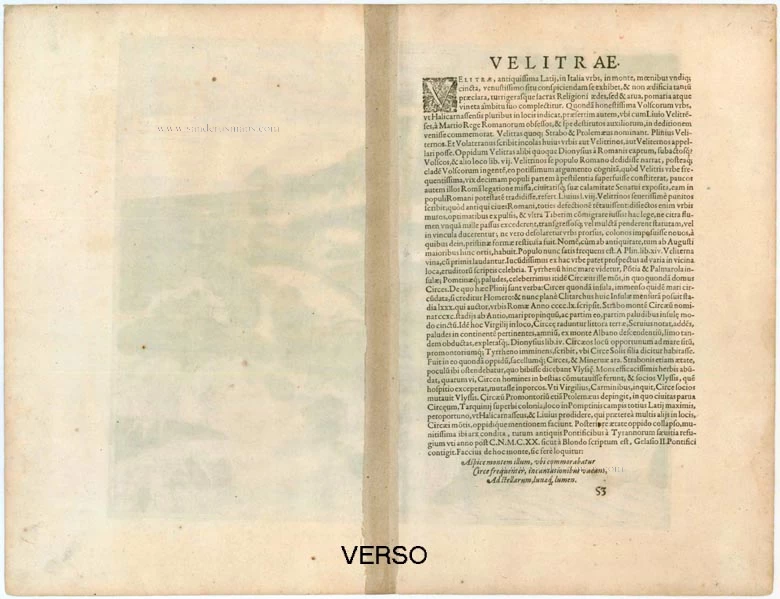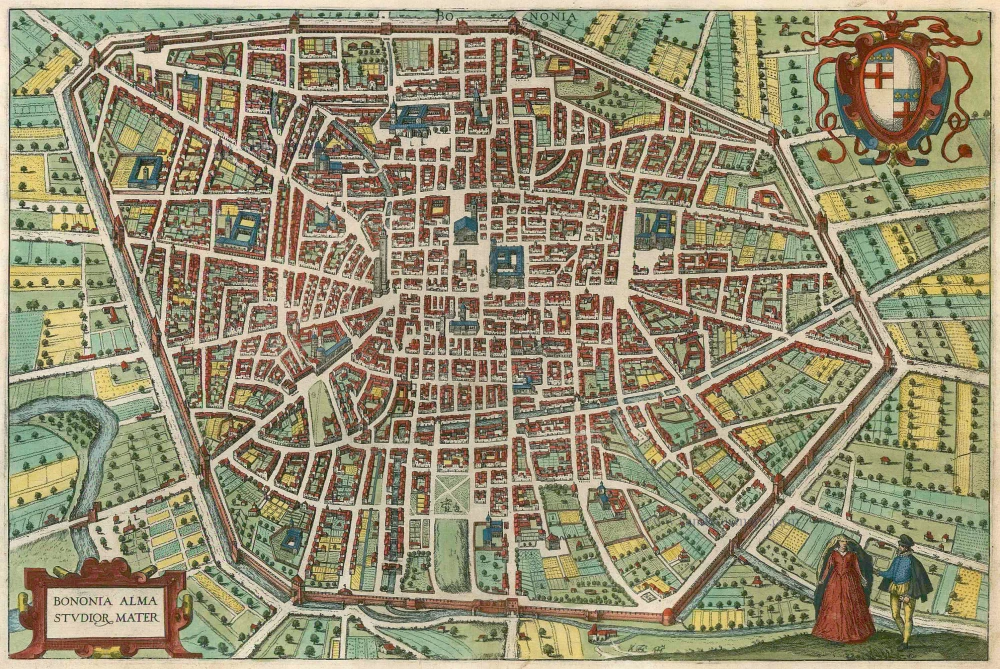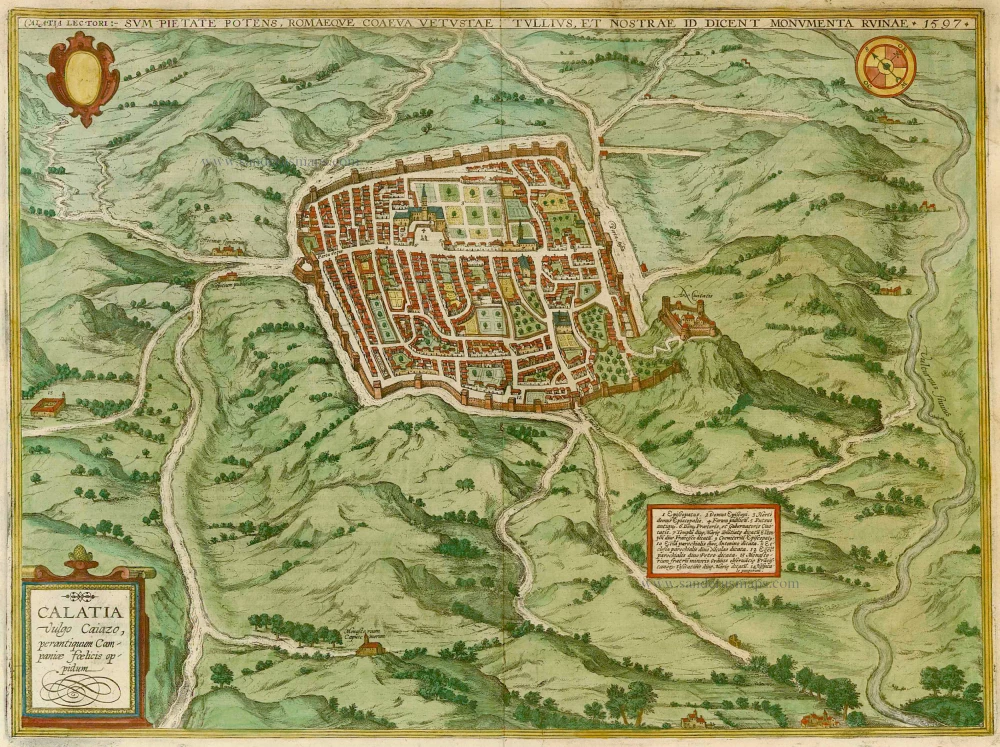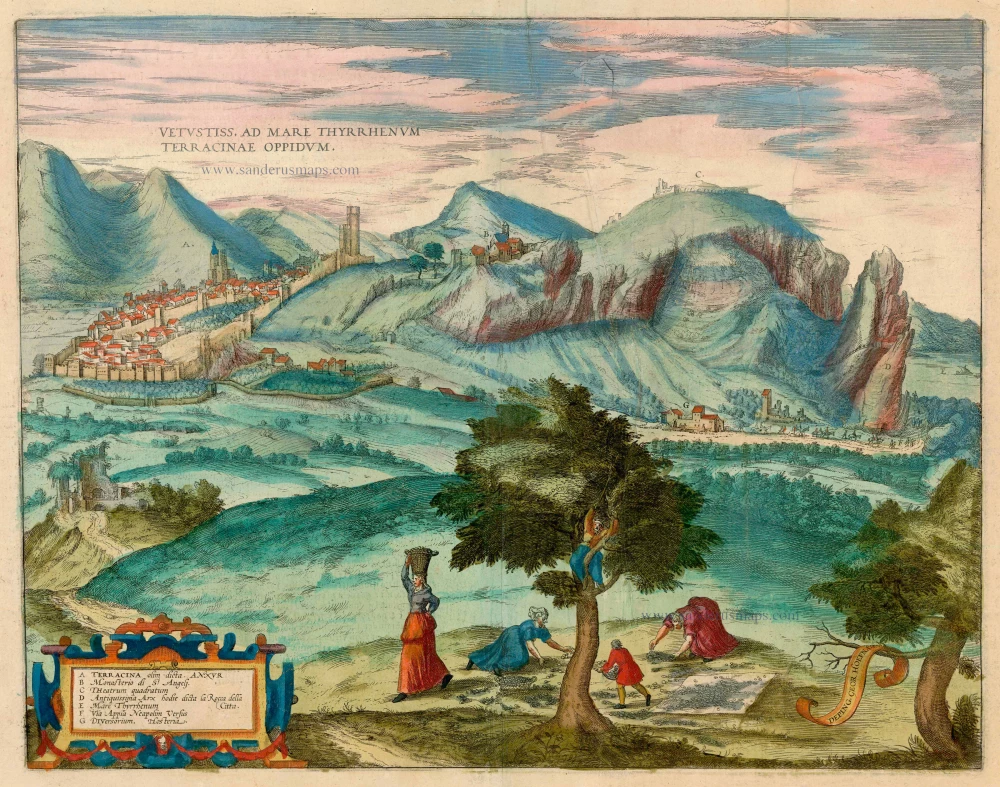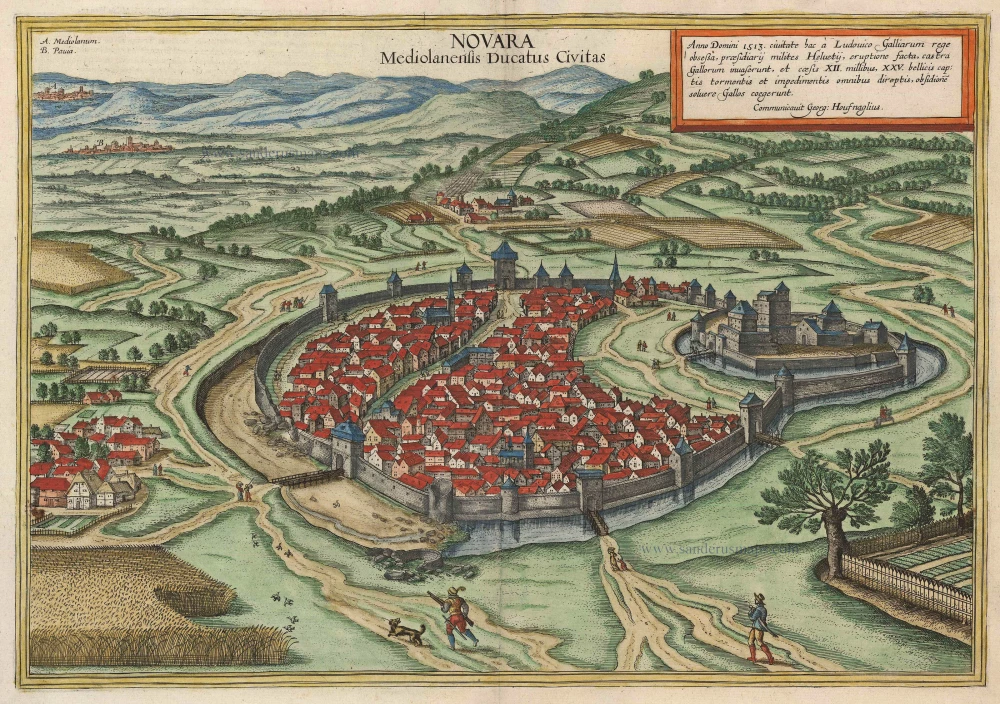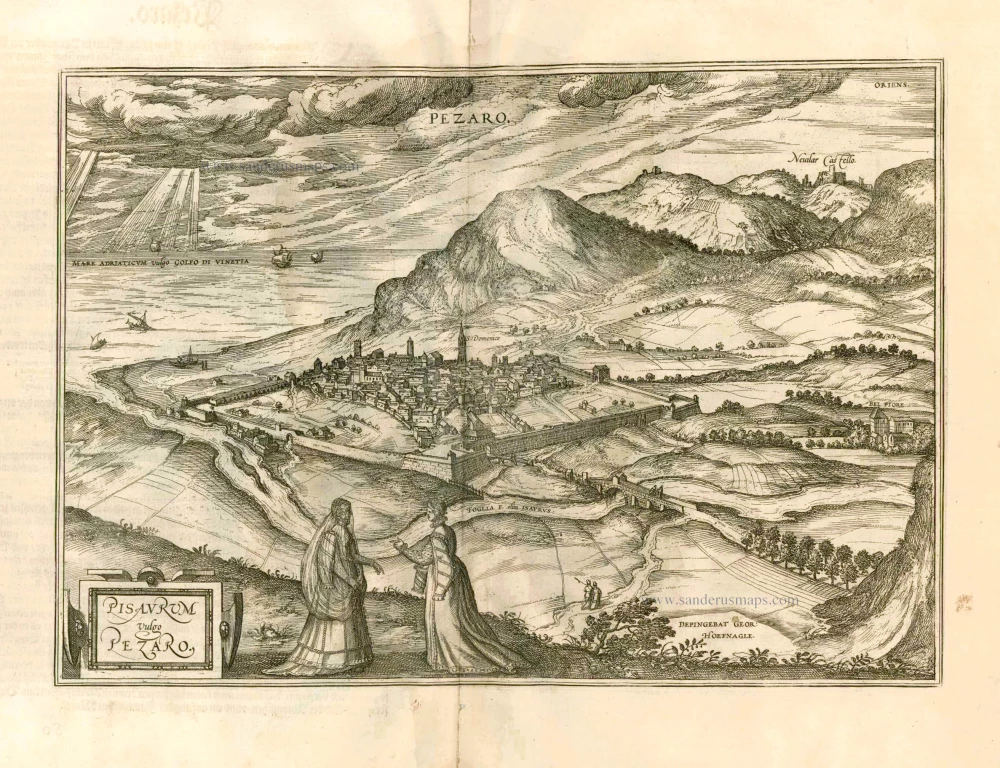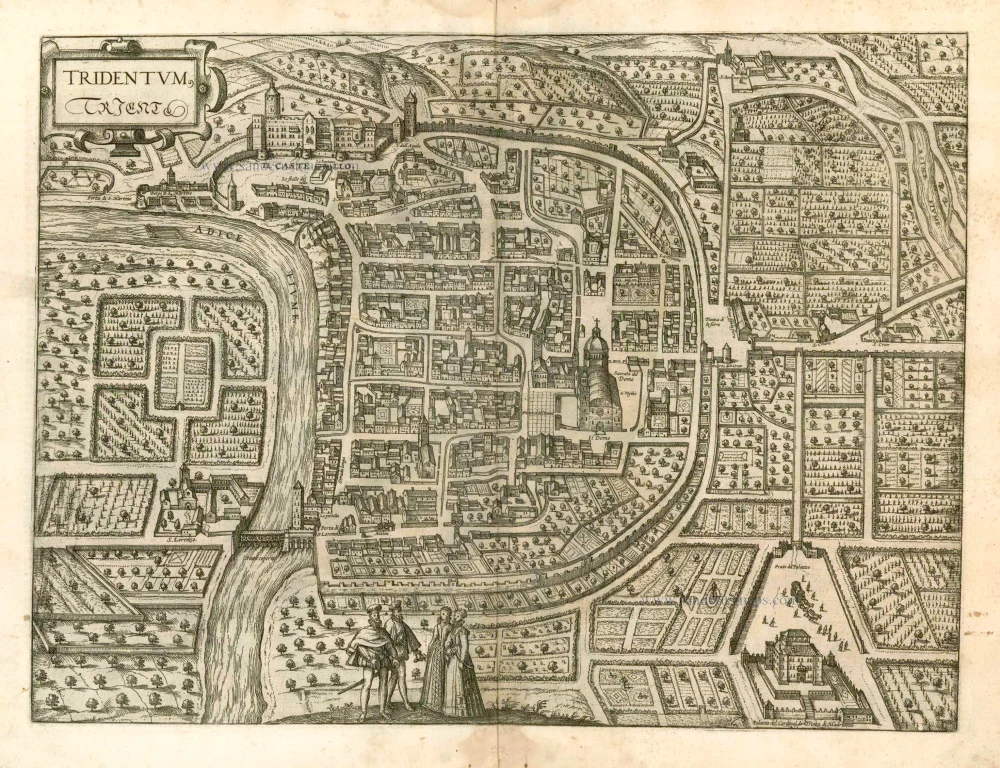Velletri by Braun and Hogenberg. 1588
The two figures in the bottom right corner are Abraham Ortelius and Georg Hoefnagel on their travels through Italy in 1578.
CARTOUCHE: Velitrae, in Italian Velletri.
COMMENTARY BY BRAUN: "The ancient mountain town of Velletri in Latium is surrounded by a wall that encloses not only magnificently beautiful buildings and churches with tall spires, but also fields, orchards and vineyards. [...] From the town there is a good view all around, looking out over many nearby towns."
This is a view from the northwest of Velletri and the hills around Coru. On the right the Pontine marshes (D) can be seen, and in the distance Capo Circeo (A) and the Isola di Ponza (B). In the centre of the town is the church of Sancta Maria del Trivio and next to it the Gothic Torre del Trivio, the town's landmark. The spire on the right belongs to the cathedral of San Clemente I, which was the titular church of Cardinal Joseph Ratzinger, Pope Benedict XVI. Between the cathedral and the Torre del Trivio is the Palazzo Comunale, which today houses the municipal authorities and a museum. Velletri belonged to the Papal States from the Middle Ages until the unification of Italy in the 19th century. (Taschen)
Braun G. & Hogenberg F. and the Civitates Orbis Terrarum.
The Civitates Orbis Terrarum, or the "Braun & Hogenberg", is a six-volume town atlas and the most excellent book of town views and plans ever published: 363 engravings, sometimes beautifully coloured. It was one of the best-selling works in the last quarter of the 16th century. Georg Braun wrote the text accompanying the plans and views on the verso. Many plates were engraved after the original drawings of a professional artist, a professional artist, Joris Hoefnagel (1542-1600). The first volume was published in Latin in 1572, and the sixth in 1617. Frans Hogenberg created the tables for volumes I through IV, and Simon van den Neuwel made those for volumes V and VI. Other contributors were cartographers Daniel Freese and Heinrich Rantzau. Works by Jacob van Deventer, Sebastian Münster, and Johannes Stumpf were also used. Translations appeared in German and French.
Following the original publication of Volume 1 of the Civitates in 1572, seven further editions of 1575, 1577, 1582, 1588, 1593, 1599 and 1612 can be identified. Vol.2, first issued in 1575, was followed by further editions in 1597 and 1612. The subsequent volumes appeared in 1581, 1588, 1593, 1599 and 1606. The German translation of the first volume appeared from 1574 on, and the French edition from 1575 on.
Several printers were involved: Theodor Graminaeus, Heinrich von Aich, Gottfried von Kempen, Johannis Sinniger, Bertram Buchholtz and Peter von Brachel, who all worked in Cologne.
Georg Braun (1541-1622)
Georg Braun was born in Cologne in 1541. After his studies in Cologne, he entered the Jesuit Order as a novice. 1561, he obtained his bachelor's degree, and in 1562, he received his Magister Artium. Although he left the Jesuit Order, he studied theology, gaining a licentiate in theology.
Frans Hogenberg (1535-1590)
Frans Hogenberg was a Flemish and German painter, engraver, and mapmaker. He was born in Mechelen as the son of Nicolaas Hogenberg.
By the end of the 1560s, Frans Hogenberg was employed upon Abraham Ortelius's Theatrum Orbis Terrarum, published in 1570; he is named an engraver of numerous maps. In 1568, he was banned from Antwerp by the Duke of Alva and travelled to London, where he stayed a few years before emigrating to Cologne. He immediately embarked on his two most important works, the Civitates, published in 1572 and the Geschichtsblätter, which appeared in several series from 1569 until about 1587.
Thanks to large-scale projects like the Geschichtsblätter and the Civitates, Hogenberg's social circumstances improved with each passing year. He died as a wealthy man in Cologne in 1590.
Velitrae vulgo Blitri.
Item Number: 22238 Authenticity Guarantee
Category: Antique maps > Europe > Italy - Cities
Old, antique map - Bird's-eye view of Velletri by Braun and Hogenberg.
The two figures in the bottom right corner are Abraham Ortelius and Georg Hoefnagel on their travels through Italy in 1578.
CARTOUCHE: Velitrae, in Italian Velletri.
COMMENTARY BY BRAUN: "The ancient mountain town of Velletri in Latium is surrounded by a wall that encloses not only magnificently beautiful buildings and churches with tall spires, but also fields, orchards and vineyards. [...] From the town there is a good view all around, looking out over many nearby towns."
This is a view from the northwest of Velletri and the hills around Coru. On the right the Pontine marshes (D) can be seen, and in the distance Capo Circeo (A) and the Isola di Ponza (B). In the centre of the town is the church of Sancta Maria del Trivio and next to it the Gothic Torre del Trivio, the town's landmark. The spire on the right belongs to the cathedral of San Clemente I, which was the titular church of Cardinal Joseph Ratzinger, Pope Benedict XVI. Between the cathedral and the Torre del Trivio is the Palazzo Comunale, which today houses the municipal authorities and a museum. Velletri belonged to the Papal States from the Middle Ages until the unification of Italy in the 19th century. (Taschen)
Date of the first edition: 1581
Date of this map: 1588
Copper engraving
Size: 40 x 342cm (15.6 x 133.4 inches)
Verso text: Latin
Condition: Contemporary old coloured, excellent.
Condition Rating: A
References: Van der Krogt 4, 4598; Fauser, #14664; Taschen, Braun and Hogenberg, p.257
From: Civitates Orbis Terrarum. . Liber tertius. Cologne, Gottfried von Kempen, 1588. (Van der Krogt 4, 41:1.3)
The two figures in the bottom right corner are Abraham Ortelius and Georg Hoefnagel on their travels through Italy in 1578.
CARTOUCHE: Velitrae, in Italian Velletri.
COMMENTARY BY BRAUN: "The ancient mountain town of Velletri in Latium is surrounded by a wall that encloses not only magnificently beautiful buildings and churches with tall spires, but also fields, orchards and vineyards. [...] From the town there is a good view all around, looking out over many nearby towns."
This is a view from the northwest of Velletri and the hills around Coru. On the right the Pontine marshes (D) can be seen, and in the distance Capo Circeo (A) and the Isola di Ponza (B). In the centre of the town is the church of Sancta Maria del Trivio and next to it the Gothic Torre del Trivio, the town's landmark. The spire on the right belongs to the cathedral of San Clemente I, which was the titular church of Cardinal Joseph Ratzinger, Pope Benedict XVI. Between the cathedral and the Torre del Trivio is the Palazzo Comunale, which today houses the municipal authorities and a museum. Velletri belonged to the Papal States from the Middle Ages until the unification of Italy in the 19th century. (Taschen)
Braun G. & Hogenberg F. and the Civitates Orbis Terrarum.
The Civitates Orbis Terrarum, or the "Braun & Hogenberg", is a six-volume town atlas and the most excellent book of town views and plans ever published: 363 engravings, sometimes beautifully coloured. It was one of the best-selling works in the last quarter of the 16th century. Georg Braun wrote the text accompanying the plans and views on the verso. Many plates were engraved after the original drawings of a professional artist, a professional artist, Joris Hoefnagel (1542-1600). The first volume was published in Latin in 1572, and the sixth in 1617. Frans Hogenberg created the tables for volumes I through IV, and Simon van den Neuwel made those for volumes V and VI. Other contributors were cartographers Daniel Freese and Heinrich Rantzau. Works by Jacob van Deventer, Sebastian Münster, and Johannes Stumpf were also used. Translations appeared in German and French.
Following the original publication of Volume 1 of the Civitates in 1572, seven further editions of 1575, 1577, 1582, 1588, 1593, 1599 and 1612 can be identified. Vol.2, first issued in 1575, was followed by further editions in 1597 and 1612. The subsequent volumes appeared in 1581, 1588, 1593, 1599 and 1606. The German translation of the first volume appeared from 1574 on, and the French edition from 1575 on.
Several printers were involved: Theodor Graminaeus, Heinrich von Aich, Gottfried von Kempen, Johannis Sinniger, Bertram Buchholtz and Peter von Brachel, who all worked in Cologne.
Georg Braun (1541-1622)
Georg Braun was born in Cologne in 1541. After his studies in Cologne, he entered the Jesuit Order as a novice. 1561, he obtained his bachelor's degree, and in 1562, he received his Magister Artium. Although he left the Jesuit Order, he studied theology, gaining a licentiate in theology.
Frans Hogenberg (1535-1590)
Frans Hogenberg was a Flemish and German painter, engraver, and mapmaker. He was born in Mechelen as the son of Nicolaas Hogenberg.
By the end of the 1560s, Frans Hogenberg was employed upon Abraham Ortelius's Theatrum Orbis Terrarum, published in 1570; he is named an engraver of numerous maps. In 1568, he was banned from Antwerp by the Duke of Alva and travelled to London, where he stayed a few years before emigrating to Cologne. He immediately embarked on his two most important works, the Civitates, published in 1572 and the Geschichtsblätter, which appeared in several series from 1569 until about 1587.
Thanks to large-scale projects like the Geschichtsblätter and the Civitates, Hogenberg's social circumstances improved with each passing year. He died as a wealthy man in Cologne in 1590.

